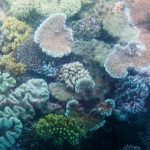Opinion: Not dead yet — the largest living thing on Earth thought dead
Outside Online pronounced the Great Barrier Reef dead at twenty-five million years old on Oct. 11.
This article spread like wildfire throughout social media, causing users to mourn the loss of this natural wonder. This article — written like an obituary — explains how the reef suffered through “mass-bleaching” and high sea temperatures, causing the corals to turn white and die. The carbon in the water caused it to be highly acidic and “dissolve” the living reef, as stated by Outside Online.
Eighteen-year-old Pranav Marla says, “I honestly thought the reef was dead and like, I couldn’t do anything but share that article and talk about it with my friends.” Marla, like many others, took the news at face value and gave up on helping.
The Great Barrier Reef is the largest living structure in the world. It was built and is composed of billions of coral polyps. In 1981, it was named as a World Heritage Site. It’s currently home to over one thousand species of fish, six species of sea turtles, almost thirty species of dolphins and whales, and many species of coral, mollusks and birds. If the reef dies, it will lead to a loss of wildlife, a loss of food, and, according to Kent Carpenter, a professor at Old Dominion University, “a complete collapse of the entire marine ecosystem.”
Russell Brainard, chief of the Coral Reef Ecosystem, explains that they’re far from an obituary during an interview with Huffington Post. Terry Hughes, director of the Australian Research Council Centre of Excellence for Coral Reef Studies, says in the same article, “The message should be that it isn’t too late for Australia to lift its game and better protect the Great Barrier Reef, not we should all give up because the Great Barrier Reef is supposedly dead.” Both Brainard and Hughes believe in being optimistic while facing an issue of such magnitude. “These natural systems do have some ability to be resilient and bounce back,” Brainard claims.
In an article by the Guardian — in reference to the article published by Outside — Kim Cobb, a coral reef expert at Georgia Tech says, “This is a fatalistic, doomsday approach to climate change that isn’t going to engage anyone and misinforms the public.”
Although Outside Online published the article as satire, the very serious problems threatening the reef are not. Mass bleachings started in the winter of 1997- 1998 have severely impacted the reef. In fact, the mass-bleaching that took place this year destroyed 22 percent of the coral population in the Great Barrier Reef. All in all, the mass-bleachings affected almost 93 percent of the entire reef since 1997, which does put it at the risk of extinction. However, experts do not yet deem the reef as extinct.
The Great Barrier Reef not only acts as a home to thousands of species of animals, it also plays a vital role in the tourism and fishing industries in Australia. It is a supplier of almost 69,000 jobs and $6 billion annually. One of the most popular tourist attractions, the reef is known for its sparkling waters, abundant wildlife and exquisite corals.
When the article by Outside Online first came out, I was appalled at the news, believing for a moment there really was nothing else I could do to help. After a quick read beyond the headline, it became clear we should not have taken the article at face value. The Great Barrier Reef is not dead, but the carelessness of humans continues to kill it, as well as the way we treat our environment. This article was meant as a jolt back to reality to help people understand that we need to take action, and we need to do it now. However, a majority of the readers took it the wrong way.
While Outside meant for the article to be a joke, believing there’s nothing else we are capable of doing is the most dangerous thing we can do for the reef right now. By not facing the urgency of this issue, we might lose the largest living thing on the planet. It’s time to do more.






